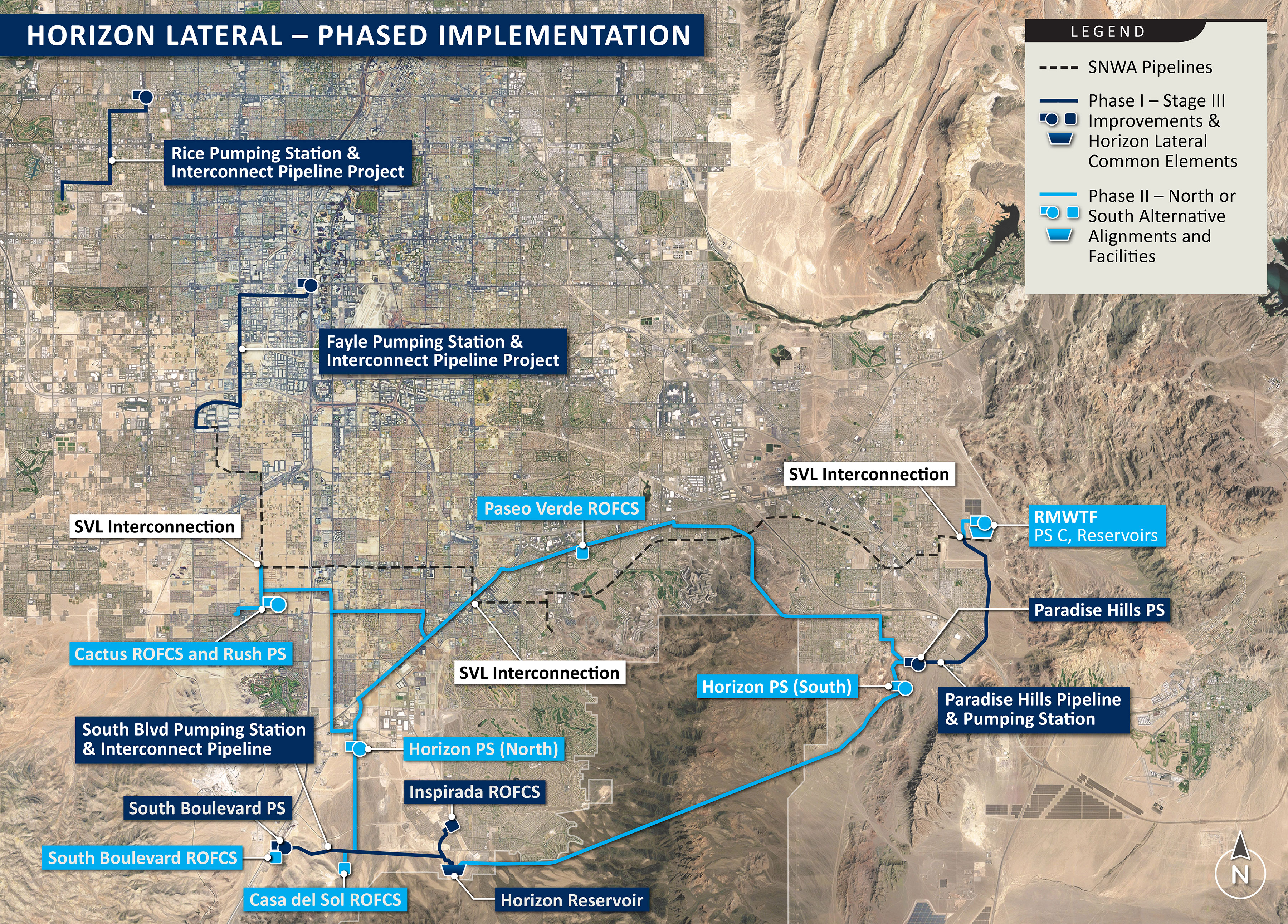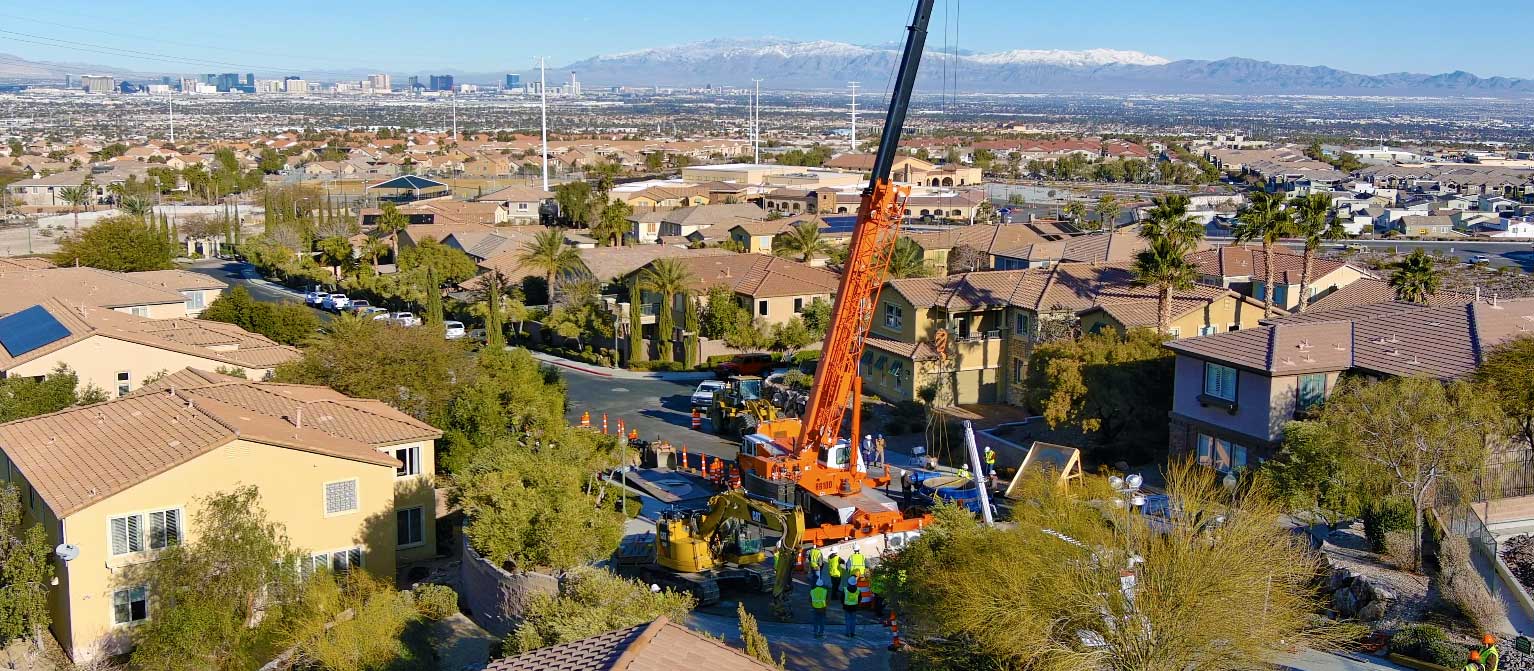As the region's water supplier, SNWA initiates projects and programs to meet the changing water needs of its member agencies and the community. This includes major infrastructure investments to strengthen the existing water delivery system.
As such, SNWA has proposed new infrastructure to improve the redundancy, reliability and flexibility of water delivery to the City of Henderson and the southern Las Vegas Valley.
Called the Horizon Lateral Program, this package of individual transmission and storage projects will protect service for nearly a million existing customers and strengthen SNWA's regional distribution network while allowing flexibility to meet Southern Nevada’s future water demands.
The Horizon Lateral Program will convey Southern Nevada's currently allocated water resources and does not require the development of new water resources.
Program's purpose
Current water deliveries to Henderson and the valley's southern region are provided by an existing large-diameter transmission pipeline known as the South Valley Lateral (SVL). Completed in the 1990s, this pipeline was built before much of the south valley was developed.
After conducting analysis and planning studies in 2019, SNWA proposed new conveyance infrastructure – known as the Horizon Lateral Program – to work in tandem with the SVL and fortify the regional water delivery system.
Through a phased build-out of the overall Horizon Lateral Program, individual projects within the Program will be prioritized to address near-term needs and help ensure Southern Nevada's regional water system remains one of the most reliable in the nation.
Program components
The Horizon Lateral Program consists of a variety of independent projects designed to enhance storage capacity, improve delivery routes, strengthen system resiliency and provide water system redundancy (system support).
Program components include:
- Improvements to existing water delivery and storage facilities in the Las Vegas Valley Water District (LVVWD) service area to boost redundancy and operational flexibility throughout the regional water system.
- A new transmission pipeline and pumping station facility to serve the southeastern portion of the City of Henderson.
- New pressure regulating valves to strengthen service and system stability during outages or emergencies.
- A new transmission pipeline, reservoir and pumping station facility to boost service reliability in the southern portions of LVVWD and Henderson service areas.
Once finished, these independent program components will interconnect to complete the overall Horizon Lateral Program, linking SNWA's east and west valley distribution networks, improving operational flexibility and enhancing system capacity to accommodate the community’s current and future water needs.
This programmatic approach ensures that SNWA can adapt to future challenges in a cost-effective manner while maintaining reliable and efficient water service for existing customers.
Frequently asked questions about the Horizon Lateral Program
Yes. Forty percent of Southern Nevada's drinking water is delivered through the South Valley Lateral (SVL), which serves nearly a million existing customers and lacks the redundancy (system support) to maintain service in case of emergencies. Once completed, the Horizon Lateral Program will protect and improve water delivery for current and future customers.
Municipal water systems add redundancy in the form of dual feeds (transmission pipelines and associated facilities) to improve reliability of water delivery – so that when you turn on the tap, that demand is consistently met. Moreover, redundancy enhances SNWA's ability to prevent and recover from emergencies such as pipeline leaks and outages.
The need for redundancy was highlighted in 2017 when the SVL was temporarily shut down for emergency repairs, requiring SNWA and the City of Henderson to temporarily reconfigure water delivery operations to continue meeting customer demands. While all customers remained in water service, the event emphasized the need to develop additional transmission facilities to help ensure system reliability.
Maintaining a world-class water system requires ongoing infrastructure repair, upgrade and investment. As such, SNWA uses a programmatic approach to address uncertainty and adapt to changes in water demands, population growth, conservation, climate change and other economic variables.
To adapt to these uncertainties, SNWA methodically designs and constructs projects based on actual water demand. This adaptive strategy ensures real-time responsiveness to changing conditions, maintains SNWA’s fiduciary responsibility to ratepayers and supports the efficient operation of a reliable water delivery system.
This programmatic approach allows us to:
- Consistently serve customers without interruptions.
- Safeguard public health and safety by preventing and recovering from system failures.
- Support the economy by meeting current and projected seasonal and regional water needs.
The Horizon Lateral Program is a result of this programmatic approach.

The Horizon Lateral Program includes independent projects built in phases to meet near-term and long-term water infrastructure needs. The first phase of the program will add redundancy to the Las Vegas Valley Water District and City of Henderson water systems in the event of an emergency on the South Valley Lateral.
Phase I projects include:
Rice Pumping Station and Interconnect Pipeline
- Construction of 30-million-gallon (MG) pumping station at the existing Rice Facility in western portion of the valley.
- Installation of 22,000 linear feet of interconnecting pipeline to convey water from the Rice Facility to the Spring Mountain-Durango Facility.
Fayle Pumping Station and Interconnect Pipeline
- Construction of 50 MG pumping station at the existing Fayle Facility in the southwestern portion of the valley.
- Installation of 28,000 linear feet of interconnecting pipeline to convey water from the Fayle Facility to the Warm Springs Facility.
Horizon Reservoir
- Construction of a 20 MG reservoir west of Nawghaw Poa Road and south of Democracy Drive; ultimately expanding to 40 MG as needed.
Inspirada Rate of Flow Control Station
- Construction of 90 MG pumping station within the City of Henderson to convey water through Henderson from the Horizon Reservoir via a 60-inch diameter pipeline.
South Boulevard Pumping Station and Pipeline
- Construction of 20 MG pumping station in southern portion of the valley.
- Installation of 20,000 linear feet of pipeline from the Horizon Reservoir west to the proposed Inspirada Rate of Flow Control Station (ROFCS).
Paradise Hills Pumping Station and Pipeline
- Construction of 35 MG pumping station west of Nevada State University.
- Installation of 22,000 linear feet of pipeline interconnecting the pumping station with the River Mountains Water Treatment Facility.
Pressure Regulating Valves
- Installation of pressure reducing valves within the City of Henderson to strengthen service reliability and reduce the potential for water service outages.
The final design process for Phase I projects has begun. Construction is expected to start in early 2027 and reach completion in 2030.
Subsequent phasing of the Horizon Lateral Program components, including interconnecting transmission pipelines, will be constructed as needed. Expected future projects include the following (listed alphabetically):
- Cactus ROFCS
- Casa Del Sol ROFCS
- Horizon Lateral Pipeline
- Horizon Pumping Station/Paradise Hills Pumping Station Expansion
- Horizon Reservoir Expansion
- Paradise Hills Power Line and Newport Substation Modifications
- River Mountains Water Treatment Facility Additions
- Rush Pumping Station
Over the past quarter century, community-wide conservation has saved hundreds of billions of gallons of water, thus reducing strain on the South Valley Lateral and allowing SNWA to explore ways to meet current and future water system needs in a planned and programmed manner.
In March 2023, SNWA and local water agencies conducted an analysis to evaluate water demand scenarios and other economic variables to optimize the existing system while strategically constructing and enhancing water transmission infrastructure to convey water between different service areas within the valley.
Stakeholder analysis concluded that improvements to existing facilities, in combination with a phased construction approach, will substantially improve system redundancy and reliability by 2030 while increasing operational flexibility to adapt to future water needs.
Two potential construction routes were developed through a comprehensive feasibility study completed in 2021 and updated by the Sensitivity Analysis in 2023.
The preferred "south alignment" would minimize public impacts by tunneling underneath the Sloan Canyon National Conservation Area to install a portion of the pipeline.
The "north alignment" would be constructed within some of the south valley's busiest streets and require traffic detours and temporary closures of roads, various parks and trails.
The selected alignment will be identified through the environmental and federal permitting process. The selected alignment will eventually connect Phase 1 and Phase 2 infrastructure.
Representatives from SNWA, LVVWD, the cities of Henderson and North Las Vegas, and the consultant team from Black & Veatch collaborated on the proposed alignments. U.S. Bureau of Land Management officials attended portions of these multi-agency meetings.
No. The Horizon Lateral Program is designed to boost water service reliability for nearly a million existing customers and strengthen the regional water distribution system, which benefits current and future water users.
Based on moderate water demand projections, SNWA has determined that it can meet the target level of system redundancy and reliability by 2030 and adapt as necessary to accommodate the community's future water needs.
While cost estimates could change, the current estimated construction cost for the entire program ranges from $2 billion to $2.7 billion. The program will be funded locally through regional connection fees paid by developers and the SNWA's infrastructure and commodity charges paid by all Southern Nevada water users.
No. The Horizon Lateral Program will convey currently allocated water and does not include the development of new water resources. Therefore, SNWA will continue to operate one of the nation's most comprehensive, innovative and progressive conservation programs. As a global leader in water conversation, our commitment to responsible stewardship remains steadfast.
Yes. In 2019, the SNWA Board of Directors convened the Integrated Resource Planning Committee (IRPAC) to evaluate and make recommendations on long-term planning efforts.
Made up of members who represent small business, gaming, homebuilders, economists, ratepayers and environmental interests, the 11-member citizens committee met seven times between Oct. 30, 2019, and March 4, 2020.
The Horizon Lateral was included in IRPAC's final recommendations for the SNWA's long-term capital improvement projects.
SNWA has also engaged with residents, homeowners associations, property owners, and the business community to keep them informed about the program.
Those interested in more information about the Horizon Lateral Program can email us.
